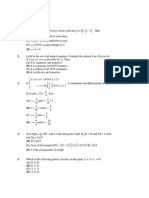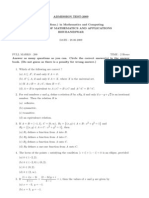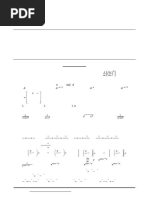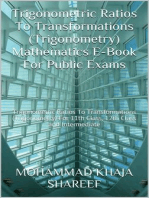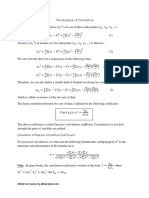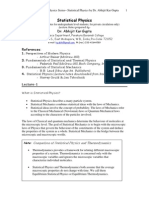Class Test-Vector Analysis
Uploaded by
Abhijit Kar GuptaClass Test-Vector Analysis
Uploaded by
Abhijit Kar GuptaPhysics Department, Panskura Banamali College by Dr.
Abhijit Kar Gupta
Physics Hons., 1st Year : Surprise Test-2006 on Vector Analysis
(Tick the correct answer)
) ) ) ) ) )
1. If the two vectors are A = 3i + 4 j + k and B = i − j + k then
(a) they are orthogonal, (b) orthonormal (c) anti-parallel, (d) none of these
1ˆ 3 ˆ
2. The directional derivative of f ( x, y ) = x 2 + y 2 at (1,1) along uˆ = i+ j is
2 2
2+ 3
(a) , (b) 0, (c) 1 + 3 (d) 1
2
1
3. If φ = , then ∇ 2φ is
r
1
(a) 1, (b) -1, (c) 0, (d) 2
r
r
4. ∇ × 2 =?
r
)
(a) r , (b) 0, (c) − r , (d) r
) ) dr
5. For a particle moving in a circular orbit r = i r cos ωt + j r sin ωt , the value of r × is
dt
) ) ) ) )
(a) i ωr , (b) k ωr 2 , (c) j ωr 2 , (d) i ωr 2 + j ωr 2
) )
6. If we have a force F = yi + xj , then the work done along a circular path in the xy-
π
plane from θ = 0 to θ = is
2
(a) π , (b) 2 π , (c) 0, (d) 1
7. If V = ω × r , and ω is a constant vector then ∇ × V =?
(a) ω , (b) 2ω , (c) − ω , (d) 0
r
8. The vector is
r3
(a) irrotational, (b) solenoidal, (c) both irrotational and solenoidal, (d) none of these
( )
9. If a is a constant vector and r is the radius vector then ∇ × a × r = ?
(a) a , (b) 2 a , (c) 0, (d) r
10. Find the angle between two vectors a and b if a × b = a ⋅ b
(a) 30 o , (b) 0, (c) 45 o , (d) 90 o
You might also like
- 2766IIT JEE Mathematics Question Papers 2000No ratings yet2766IIT JEE Mathematics Question Papers 20005 pages
- Vectors & 3-D Geometry - 1HHHHHHHHHHHHHHHHHHHHHHNo ratings yetVectors & 3-D Geometry - 1HHHHHHHHHHHHHHHHHHHHHH3 pages
- Problems For Exercise of Vector CalculusNo ratings yetProblems For Exercise of Vector Calculus19 pages
- Ramakrishna Mission Vidyamandira: Full Marks: 50No ratings yetRamakrishna Mission Vidyamandira: Full Marks: 503 pages
- First Semester B.E. Examination Engineering Mathematics-I (06MAT11)100% (1)First Semester B.E. Examination Engineering Mathematics-I (06MAT11)6 pages
- N N N N: The Images Are Appearing Blurred As We Have Tried To Keep Small Size of The PDFNo ratings yetN N N N: The Images Are Appearing Blurred As We Have Tried To Keep Small Size of The PDF11 pages
- PU II five Model Question Papers for Annual exam 2024-25 .No ratings yetPU II five Model Question Papers for Annual exam 2024-25 .15 pages
- Dibrugarh University Entrance Examination For M.Sc. in Physics Question Papers100% (2)Dibrugarh University Entrance Examination For M.Sc. in Physics Question Papers12 pages
- Maths Class Xii Sample Paper Test 02 for Board Exam 2025 QpNo ratings yetMaths Class Xii Sample Paper Test 02 for Board Exam 2025 Qp6 pages
- Paper: Iit-Jam 2014: (Objective Questions)No ratings yetPaper: Iit-Jam 2014: (Objective Questions)6 pages
- Maths Class Xii Sample Paper Test 6 For Board Exam 2024No ratings yetMaths Class Xii Sample Paper Test 6 For Board Exam 20246 pages
- Class 12_kst Study Point_kv Lucknow Preboard Qp 2023-24No ratings yetClass 12_kst Study Point_kv Lucknow Preboard Qp 2023-2414 pages
- RSy 1 DOq KO04 DUs QCZutv Yk Kled E8 Di OKg DK L1 EKaNo ratings yetRSy 1 DOq KO04 DUs QCZutv Yk Kled E8 Di OKg DK L1 EKa7 pages
- Coordinate Geometry - Arihant Skills in Maths - (Jeebookreader.blogspot.com)-171-181No ratings yetCoordinate Geometry - Arihant Skills in Maths - (Jeebookreader.blogspot.com)-171-18111 pages
- Section A: (Affiliated by CBSE - NEW DELHI)No ratings yetSection A: (Affiliated by CBSE - NEW DELHI)4 pages
- Analytic Geometry: Graphic Solutions Using Matlab LanguageFrom EverandAnalytic Geometry: Graphic Solutions Using Matlab LanguageNo ratings yet
- De Moiver's Theorem (Trigonometry) Mathematics Question BankFrom EverandDe Moiver's Theorem (Trigonometry) Mathematics Question BankNo ratings yet
- Trigonometric Ratios to Transformations (Trigonometry) Mathematics E-Book For Public ExamsFrom EverandTrigonometric Ratios to Transformations (Trigonometry) Mathematics E-Book For Public Exams5/5 (1)
- Path Analysis For Linear Multiple RegressionNo ratings yetPath Analysis For Linear Multiple Regression3 pages
- Solution To Question Paper IV, V.U. 2013No ratings yetSolution To Question Paper IV, V.U. 20139 pages
- Lectures On Theoretical Mechanics - 7 (Rotating Coordinate System: Coriolis Force Etc.)100% (1)Lectures On Theoretical Mechanics - 7 (Rotating Coordinate System: Coriolis Force Etc.)6 pages
- Moments and Products of Inertia, Inertia Tensor100% (1)Moments and Products of Inertia, Inertia Tensor4 pages
- Measurement of Average Sky Glow by Digital CameraNo ratings yetMeasurement of Average Sky Glow by Digital Camera6 pages
- Stat Phys Lecture Notes For Undergrad Students100% (2)Stat Phys Lecture Notes For Undergrad Students33 pages

















